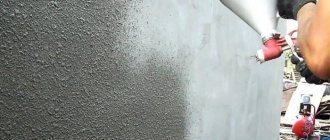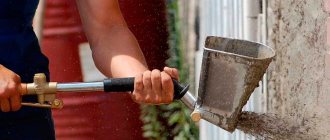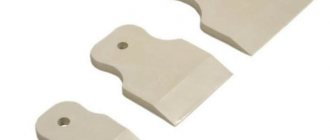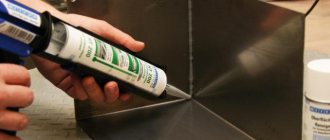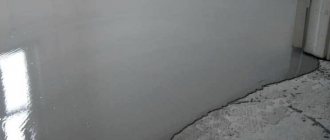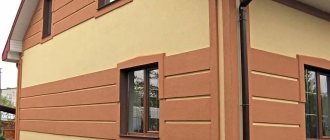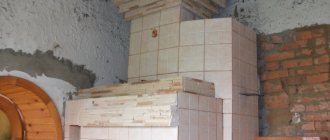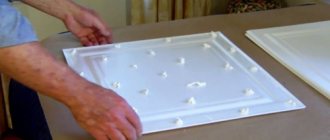Plastering large areas of walls and ceilings and leveling facades manually is time-consuming, expensive and impractical, especially when you need to get the most even surface possible in the shortest possible time. After all, in summer the concrete solution dries too quickly, it has to be diluted in small quantities, and this is a waste of precious time. To significantly speed up the plastering of walls, it is better to use a plaster hopper bucket. Also, a big advantage of this tool is that the solution is applied very efficiently, and in order to cope with it, you do not have to be a professional builder. In addition, it is easy to make a pneumatic ladle for plaster with your own hands.
Design features
The hopper bucket for applying plaster can be factory-made or homemade. The first are available in two types: ceiling and wall. They differ in the design of the handle. For ceiling tools it is bent at a right angle, for wall tools it is bent at an angle of 45 degrees.
Thanks to the hopper, better adhesion of the solution is ensured; it gets into almost any crack. The quality of the coating is much better due to the high impact force of the mixture. Depending on the application, hoppers are equipped with compressors of varying power, and there are also adjustable nozzles. The bucket is completely freed from the solution in 5-10 seconds, which is why it is capable of processing up to 60 square meters. m surface in a layer of up to 2-3 cm. After spraying, the solution is leveled with a wide spatula.
What is a hopper bucket - what is it for?
A hopper bucket or plastering shovel is a mechanized device for applying leveling mortar by spraying. The operating principle of the tool is based on supplying compressed air to a container with a mixture. The working mass is blown out of the reservoir under pressure through nozzles.
Structurally, the device is presented as follows:
- plaster ladle for mortar in the shape of a truncated cone;
- handle with trigger;
- an electric compressor connected to the equipment with a hose.
Near the bottom of the container, nozzles with a diameter of up to 20 mm are located on the front walls at different angles. Depending on the type of instrument, they can be stationary or removable.
General advantages and disadvantages of use
The main advantage of plastering using a hopper bucket is the mechanization of the process. This results in the following advantages:
- high efficiency (3-4 times more volume is covered with the mixture, about 50-60 sq. m. per shift);
- uniform distribution of the solution over the entire working surface;
- improved adhesion of the plaster to the base due to the pressure exerted by compressed air;
- compactness and accessibility relative to cost for the private sector;
- versatility in terms of working solutions: leveling and decorative plaster, putty, “liquid” wallpaper.
They also note the ease of use of the tool. You don't need to be a master here. Servicing the device does not take much time and resources, and does not require special tools or skills.
The equipment is suitable for working with various compositions:
- plaster;
- cement;
- lime;
- polymeric;
- combined.
The disadvantages include the following:
- The plaster hopper itself weighs a little (on average 2-2.5 kg), but with the solution the weight reaches 12-15 kg. If the container is partially filled, you will have to frequently remove the working mixture.
- The second disadvantage is cleanliness. The spraying method is always accompanied by splashes that spread to the floor and the artist.
There is an opinion that the consumption of plaster decreases when using the device. This is justified by the fact that the falling mixture can be returned to the ladle and sprayed on the walls again. However, some of the splashes remain outside the coating, and the solution is prepared thick. As a result, there is a slight increase in consumables while working with spatulas.
The main advantages of the hopper plastering bucket and reviews
- Affordable price.
- You can buy a shovel with a compressor attachment separately or a ready-made station.
- Quick payback by minimizing manual labor costs.
- Simplicity of design and ease of operation.
- Reliability and durability of parts, compressors break in most cases.
- To work with it, you do not need special education or skills; you need to be in good physical shape.
- The speed of plastering increases significantly, because one person controls the hopper, and the other levels the surface.
- To apply liquid adhesives and paint, you can use a portable ladle - a special gun.
- Saving solution.
- Increased coating quality and reduced risk of deformation of the treated surface.
- Adhesion increases several times.
- The device can be made directly on the construction site from available materials.
Users appreciated all the listed advantages of this tool, so the hopper bucket received only positive reviews. They especially highlighted the affordable cost, simplicity, speed and ease of operation, and saving of solution.
Composition application technology
Let's look at how to work with a hopper bucket.
- First you need to apply the beacons, align them vertically and horizontally using starting plaster or mortar. The solution should dry and securely hold the beacons in their position.
- If you need to do shotcrete, it is additionally recommended to install reinforced mesh.
- A solution of medium density is prepared so as not to break the nozzles. Considering the high speed of applying the solution, it is better for one worker to initially prepare the solution, another to apply it, and a third to level it.
- Depending on the structure of the applied solution and its density, you need to correctly select the angle of inclination of the bucket and the distance to the applied surface. On average, the recommended distance is up to 5-10 cm.
- After the initial application of a layer of mortar, you need to level the surface with a rule or a wide spatula.
- Rinse the ladle after finishing work, blow out the nozzles and remove all traces of the solution.
If you need to take a break from work for any reason, the hopper bucket must be lowered into the water and blown with compressed air. It is strictly forbidden to leave it open, otherwise the nozzles will dry out and burst after pressing the trigger.
How to use a hopper correctly and what to consider when working with it
Spraying the solution onto the walls using a hopper ladle for plaster is carried out when connected to a compressor. Manufacturers indicate the permissible pressure in the instructions. This is usually 4-6 atmospheres. To pump air, it is recommended to use equipment with a cylinder of 100 liters or more. Here the output is about 350 liters of compressed air.
Air Sprayer for Plaster, Construction Sprayer, Plaster Hopper Gun, Spray Gun for...
Air Sprayer for Plaster, Construction Sprayer, Plaster Hopper Gun, Spray Gun for...
aliexpress.ru
Buy
Plaster Blade for Wall Mortar Jet Sprayer Hopper Bucket Cement Sprayer Air...
Cleaning the pneumatic bucket from solution
After everything that is planned has been covered with plaster, it is necessary to immediately clean the ladle of any remaining mixture. Once the lumps dry out, they will be very difficult to remove from the instrument. As a last resort, you can put the tool in water. When the plaster gets wet, it will pull away from the walls of the ladle.
Untimely cleaning leads to clogging of the nozzle, and the next time you turn on the device, it breaks, regardless of what tool is used - purchased or made by yourself.
How to make a plaster ladle with your own hands?
The bucket niche itself is made of stainless steel, all seams are welded. The shovel comes in various shapes and sizes, it can be improved for specific purposes, even combined models can be made with several nozzles at the same time. But such a bucket weighs much more. Most private owners prefer lightweight aluminum models of bent shape, connected by soldering and self-tapping screws. When connecting, cracks and gaps should not be allowed, otherwise there will be a loss of mortar and its slow compaction due to loss of water. The problem of gaps is solved with the help of rubber seals, corners and linings.
The bucket is equipped with a comfortable and durable handle located under the working hand. It is made from bent steel or aluminum tube; no plastic is used.
Spray guns and nozzles with nozzles are installed on the upper edge of the bucket. Homemade buckets have less power, but are more versatile, but factory models are often equipped with several nozzles at the same time. It is recommended to install nozzles when spraying paint and adhesives, then productivity increases. Nozzles are not used for concrete mortar; they do not fully fulfill their mission.
The finished hopper bucket is placed on the spray gun, to which the hose from the compressor is attached. When using a homemade hopper, it is better to increase the distance to the surface to be coated to 20 cm due to increased scatter. You need to take care of a manual hopper in the same way as a factory one.
The only drawback of manual hoppers is their limited use. With their help you can only process walls. Plastering ceilings is inconvenient and the consumption of mortar increases sharply. If you already need to process the ceiling, then you can remake the bucket or buy a spray gun of a different design.
Choosing a purchased hopper bucket
On trading floors, the choice of a pneumatic plastering ladle is made according to several criteria: purpose, tank volume, equipment, ease of use, quality of component elements. So, they are considering options for finishing walls, ceilings, or a universal one with replaceable equipment. The package must be checked before paying for the instrument.
What to look for, popular manufacturers
The volume of the bucket is determined by its own forces. But the material for making the tank varies. Stainless steel containers will last longer than counterparts made from other materials. For example, tin becomes deformed due to its softness, and galvanized steel wears off due to friction. You also need to pay attention to the thickness of the bucket walls and the degree of smoothness of the inner surface.
The nozzles must be reinforced and securely attached to the container. This is important due to the pressure created and the solid filler in the working solution. Rapid wear cannot be avoided, but the service life of the elements depends on the design.
Craftsmen recommend checking the number of rivets. The fewer there are, the higher the risk of holes forming in the tank. Hardware must be rolled - this is done to ensure tightness.
The starting mechanism is checked for smooth operation, the location of the channels for air inlet and outlet for symmetry. It is better to take a hose with reinforcement. The handles should fit comfortably in your hands and have a rubber coating.
Today, Zitrek brand tools with a bucket volume of 3.5 l (SN-01) and 5 l (SN-02) from Poland are in demand on the construction market. Competition comes from the domestic plaster hopper from Profmash (KSh-4).
